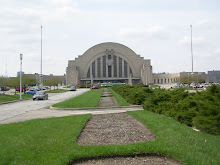Hayes & the Civil War
Part V: The Battle of Third Winchester
Hayes called his years of military service during the Civil War the best years of his life. This now six-part series in honor of his birthday will visit four locations associated with Hayes service to the Union.
The Battle of Third Winchester or Opequon took place on September 19, 1864. It is called ‘Third Winchester’ because two previous battles had taken place around the Northern Virginian town of Winchester in 1862 and 1863.
.jpg)
After Kernstown, one of Lt. General Jubal Early’s brigades burns the town of Chambersburg, PA, on July 30, 1864. U.S. Major General Phillip Sheridan was then given command of all Union forces in the Valley, replacing Hunter, following the defeat at Kernstown and the burning Chambersburg. Union forces reenter the Shenandoah and at Third Winchester, approximately 39,000 Union men under Sheridan and 15,000 Confederates do battle on the north side of town. The Union was victorious and pushed the Confederates south through the town of Winchester.
Hayes describes the battle in a letter to his Uncle Sardis, again online at the Hayes Presidential Center. Here is an excerpt:
HARRISONBURG, VIRGINIA, September 26, 1864.
“DEAR UNCLE:--You have heard enough about our great victories at Winchester and Fisher's Hill. I will say only a word. No one man can see or know what passes on all parts of a battle-field. Each one describes the doings of the corps, division, or what not, that he is with. Now, all the correspondents are with the Sixth and Nineteenth Corps and the cavalry command. General Crook has nobody to write him or his command up. They are of course lost sight of. At Winchester at noon, the Sixth and Nineteenth Corps had been worsted. In the afternoon, General Crook (who is the brains of the whole thing) with his command turned the Rebel left and gained the victory. The cavalry saved it from being lost after it was gained. My brigade led the attack on the Rebel left, but all parts of Crook's command did their duty. The Sixth Corps fought well, the Nineteenth failed somewhat, and the cavalry was splendid and efficient throughout. This is my say-so.
“My division entered the fight on the extreme right of the infantry, Merritt's splendid cavalry on our right, and Averell still further on our right. We ended the fight on the extreme left. The Rebels retreated from our right to our left, so that we went in at the rear and came out at the front, my flag being the first into and through Winchester. My division commander was wounded late in the fight and I commanded the division from that time. It is the Second, General Crook's old division . . .”
Sincerely, R.
Note: Hayes mentions the Battle of Fisher’s Hill. It is about 20 to 25 miles south-southwest from Winchester. I didn’t have enough time to visit.
Hayes is credited with leading his men south across a muddy creek called Red Bud Run. Crook’s Corp, the unit to which Hayes was attached, flanks the enemy’s left and the Confederates retreat. Hayes however is also credited with saying of the battle, "To stop was death. To go on was probably the same; but on we started again." Markers near Red Bud Run describe the action of Hayes and the 23rd Ohio.
For a more text-book description of the entire Battle of Third Winchester, click here for the Civil War Preservation Trust’s (CWPT) battle summary and here for link to the battlefield map. And click here for a further summary of the battle from the National Park Service American Battlefield Protection Program.
I visited Third Winchester on a cloudy and cold Friday afternoon. It did not make for good photos. There are 5 miles of trails with interpretive signage describing the battle along the trail, all contained on land owned by the CWPT. Standing at the very creek Hayes crossed (although not in the same location) and trying to imagine what it was like was rather moving actually.
The Confederate Flank Trail – Hayes crossed this very land
.jpg)
Huntsberry Farm beyond
.jpg)
North bank of Red Bud Run
.jpg)
.jpg)
Red Bud Run
.jpg)
Hackwood House (c. 1777) – Hayes crossed Red Bud Run (far right) and progressed to the left, behind the house
.jpg)
Hackwood Lane – Old road but the trees were not here in 1864.
.jpg)
The Middle Field – There were over 3,000 casualties here and it is considered one of “most sanguinary fields of the Civil War.”
.jpg)
The Second Woods
.jpg)
To view more of my photos from the Battle of Third Winchester, click here. To view photos from the very charming town of Winchester, click here.
However, the site is fighting the encroachment of nearby development and the Civil War Preservation Trust just finished an effort to purchase 209 additional acres near land already owned by either the CWPT or the Shenandoah Valley Battlefield Foundation. They completed their goal of $3,350,000. Click here to join the Civil War Preservation Trust (and me!) in saving the Third Winchester and other at risk battlefields.
Next:
Part VI: The Battle of Cedar Creek
Raise the Rutherford! is a continuing, slightly humorous series to raise awareness of Rutherford B. Hayes and erect a statue of him in Cincinnati.
References:
The Rutherford B. Hayes Presidential Center
Including the Dairy and Letters of Rutherford B. Hayes
Civil War Preservation Trust
National Park Service American Battlefield Protection Program
Shenandoah Valley Battlefields Foundation
Historical Marker Database
.jpg)

No comments:
Post a Comment